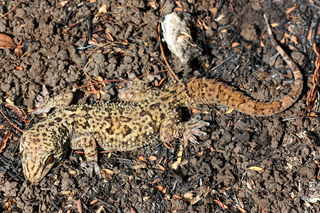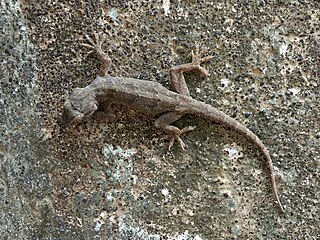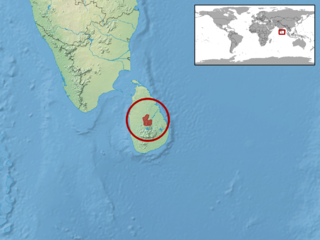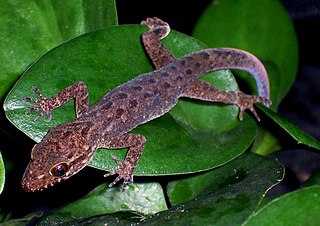
Gehyra mutilata, also known as the common four-clawed gecko, stump-toed gecko, tender-skinned house gecko, sugar gecko, Pacific gecko, or butiki, is a type of house gecko that is native to Southeast Asia and Australia. It has made its way to several areas of the world including Sri Lanka, Indochina, and many of the Pacific Islands. Compared to common house geckos, this gecko's appearance is somewhat plump, with delicate skin. The skin is usually colored a soft purplish/pinkish gray with golden spots on younger specimens; these spots eventually fade with age.

The Oriental leaf-toed gecko, also known as Bowring's gecko, Sikkimese dark-spotted gecko, or Asian smooth gecko, is a species of gecko endemic to East Asia.

Hemidactylus brookii, commonly known as Brooke's house gecko or spotted house gecko, is a widespread species of gecko.

The Indo-Pacific gecko also known as Garnot's house gecko, the fox gecko, or the Assam greyish brown gecko, is a species of gecko found in India, the Philippines, Southeast Asia, Australia, and throughout Polynesia. Adults are about 4 to 5 in in total length. They are seen as dark gray or brown with light markings in daylight and a pale, translucent colour at night. The belly is orange or yellow. The head has a long, narrow snout, hence the name fox gecko. The flattened tail has a row of spiny scales on the lateral edges. The species is parthenogenic – all individuals are female and lay eggs that hatch without requiring male fertilisation.

Hemidactylus maculatus, also known as the spotted leaf-toed gecko or giant spotted gecko, is a species of large gecko found in the Western Ghats of India and in parts of Sri Lanka.

Leschenault's leaf-toed gecko is a species of gecko, a lizard in the family Gekkonidae. The species is endemic to South Asia and parts of West Asia. It is often found inside homes. Its scientific name commemorates French botanist Jean Baptiste Leschenault de la Tour.

The flat-tailed house gecko, also known as the frilled house gecko or Asian house gecko, is a species of Gekkonidae native to southeastern and southern Asia. The species is sometimes classified under the genus Cosymbotus.

The Kandyan day gecko or Kandyan rock gecko is a species of diurnal gecko found in Sri Lanka.

Cyrtodactylus deccanensis, also commonly known as Deccan ground gecko, Günther's Indian gecko, or the banded ground gecko, is a species of gecko found in the northern Western Ghats of India. It has been found from northern Maharashtra, with a habitat range possibly extending to southern Gujarat. Cyrtodactylus albofasciatus was previously considered conspefic with Cyrtodactylus deccanensis but is now accepted as a valid species.
Cyrtodactylus nebulosus, also known as the clouded Indian gecko, is a species of gecko found in India.

The Malayan forest gecko or banded bent-toed gecko is a species of gecko found in Southeast Asia.
Hemidactylus giganteus, also known as the giant leaf-toed gecko, the giant southern tree gecko, or the giant gecko, is a species of gecko endemic to India.
The graceful lead-toed gecko is a species of small-sized gecko found in India. The holotype was described in British India in Berar.
Hemidactylus karenorum, commonly known as the Burmese leaf gecko, the Burmese leaf-toed gecko, or the Burmese spotted gecko, is a species of gecko, a lizard in the family Gekkonidae. The species is endemic to Southeast Asia.

The reticulate leaf-toed gecko is a species of terrestrial, nocturnal, insectivorous gecko found in rocky areas of South India. It takes refuge under stones on ground during day time and emerges out at night for its activities.
Hemidactylus subtriedrus, also known as Jerdon's gecko or Madras blotched gecko, is a species of gecko found in India and Sri Lanka.

Hemidactylus triedrus, also known as the termite hill gecko, Dakota's leaf-toed gecko, or blotched house gecko, is a species of gecko found in South Asia. The race lankae of Sri Lanka, is now given species status and known as Hemidactylus lankae

The Southern Ghats slender gecko is a species of gecko with a restricted distribution in the hills of southern India.

The Mediterranean house gecko is a type of house gecko common to the Mediterranean area which has spread to many parts of the world. It is commonly referred to as the Turkish gecko as represented in its Latin name and also as the moon lizard because it emerges in the evening.

The marbled bow-fingered gecko is a species of gecko found in Southeast Asia.















